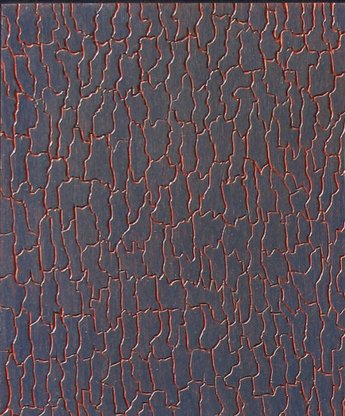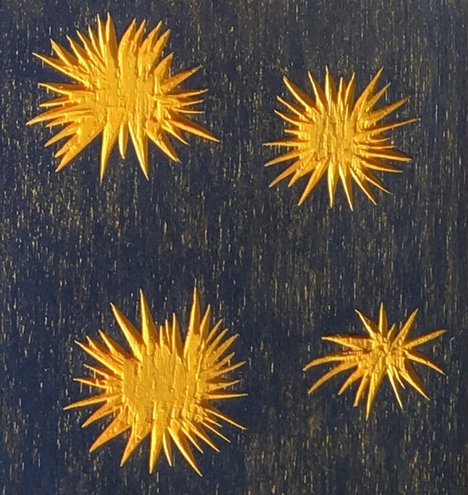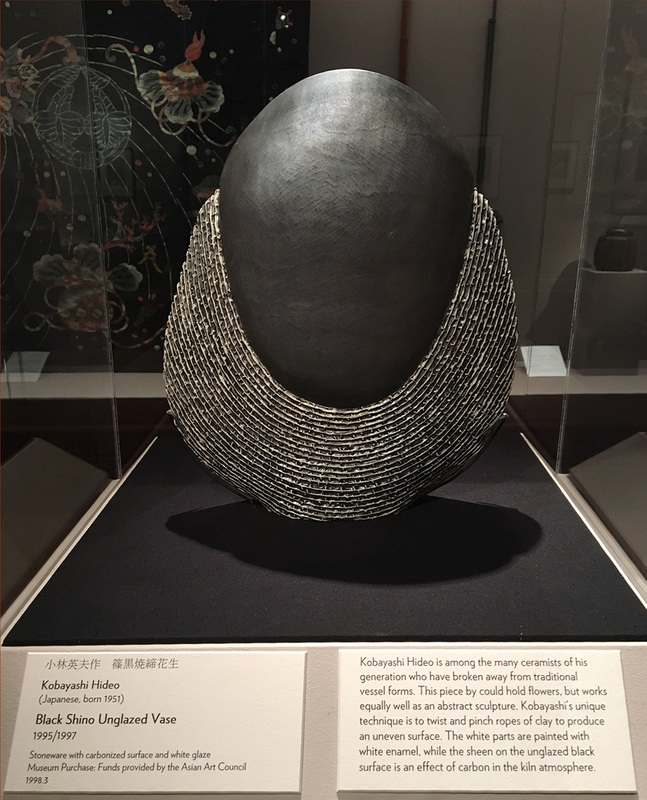|
Not long before Christmas, during a break in the rainy weather, I went with my family up to Calistoga to sample the hot springs and the wine. As is our custom, we took a hike just outside town, stopping right off the road along the Silverado Trail highway. The trail that we took is called the Oak Hill Mine Trail, and it was lovely. It reflected the classic vegetation of Northern California, with Laurel trees and California Oaks, as well as smaller bushes like Manzanita. Almost all of the trail was green and lush, and the native grasses were everywhere. Since it was winter, however, many small plants were gray and long past bloom, and these were what caught my eye. I particularly liked the small Star thistles along the trail, because of their spiky, star-like clusters, and this is what I chose for my latest carved painting. In my photo of the carving seen below, the thistle is seen on the right; the middle section shows a pattern I devised from the criss-cross of the thistle stems; and the left panel shows dried grasses that had matted together. I chose white as the color, because of the relatively wintry temperature, and because of the pale gray/white of the thistle. This was a great short hike, and what was found underfoot proved just as interesting to me as the lovely vistas.
1 Comment
One of the real joys of doing my carved paintings is the wide variety of marks that I am able to make with my carving tools. In the course of my life, I have observed that people have a deep need to leave a mark of some sort on their world. An example of this would be Grafitti, and an earler series of mine from a few years ago discussed that. Grafitti is found everywhere, from walls to bathrooms to tree trunks, and is certainly abundant in San Francisco. The genesis for that series was a stay in Barcelona, where I had visited Roman ruins on which could be seen names and words left by people from 2000 years ago. Soon after, I started to use the wood panels that I use now, since they provided a firm and stable base for the plasters that I began to coat them with, subsequent to scratching marks on them. That series led directly to my carved paintings, since the wood began to seduce me with its beauty, and I came to feel that there was no need to cover it with plaster prior to making marks.
Below are some images of marks that I have made with carving tools. Since all of these are derived from nature, I hope to explore many more in their infinite variety. Recently I have been reading a very interesting book titled "Thinking, Fast and Slow". It was written by Daniel Kahneman, a psychologist who won the Nobel Prize in Economics in 2002 for his work on human behavior and decision-making as it relates to economic choices. Mr. Kahneman is not an economist, but is a very close observer of human nature, who poses and tries to answer many questions about why and how we make certain choices in all aspects of our lives. In his book, he notes that optimism and confidence - even overconfidence - are important characteristics of research scientists. He states, " I have yet to meet a successful scientist who lacks the ability to exaggerate the importance of what he or she is doing, and I believe that someone who lacks a delusional sense of significance will wilt in the face of repeated experiences of multiple small failures and rare successes..."
This assertion resonated with me, for it reminded me of similar behaviors found in most artists. Art is a career that is fraught with economic uncertainty, and frequently meets with meager acclaim and slender financial rewards. Accordingly, artists must have a strong sense of purpose, and a strong ego to support their endeavors, They must believe that what they do is so important that it supersedes any other pursuit, and must be able to continue on their path despite the understanding that most other jobs offer more money and greater stability. For this reason, the study of art is for many a calling, and not a career in a traditional sense. That is certainly the case for me. Investigation, uncertainty, failure, striving, and restlessness are all married to the practice of art. In my case, all of these apply, and push me in a search for elusive Beauty, a quality which is easier recognized than produced. I would not have it any other way. My visit to Mt. Rainier in Washington a few months back was the inspiration for my newest carved painting titled "Mt. Rainier: Cedar Roots, Petals, and Beargrass." This piece, like the "Avalanche Lilies" mentioned in a previous blog, was based on a hike up to Comet Falls. Many parts of the trail to the falls were in shade, covered by giant cedars and fir trees. The path was made highly uneven in spots because of the tree roots exposed by the passing hikers. This was the source for the left section of this panel - the criss-cross nature of these roots, which also resemble aerial photos of marshes and tide flats.
The middle section uses as its motif the same type of pattern found in "Avalanche Lilies:" I excerpted the petal shapes from that flower, enlarged them slightly, and placed them so that they would appear to be falling gracefully. The right section features Bear Grass, which is blooming at this time of year. It is found in many parks at the sub-alpine elevation, and I have also seen it in Yosemite and at Glacier National Park in previous years.The bulbous flower is composed of many smaller blossoms, while the long, sturdy stalk appears almost hairy. The base has many thin grassy leaves that curve delicately, and intersect one another to form busy flowing lines. What a memorable hike, and what lovely things to see! While on vacation two months ago I visited Portland, Oregon, with my wife and my dear friend Amy. We stayed at a motel near the airport, which had lovely pond located very nearby. Growing by that pond were many Queen Anne's Lace flowers. True to their name, the flowers were white and lacy, and very delicate in appearance. I plucked one, took it to my room, and drew it. That drawing is the basis for the right panel of my latest carving, seen below.
The left panel is also derived from Portland, but is not taken from nature. It was based on "Black Shino Unglazed Vase", a graceful ceramic pot featured at the Portland Art Museum, done by a wonderful Japanese ceramicist named Kobayashi Hideo. The curved lines found at the base of it inspired me to use similar lines in my carving. As in often the case, the act of carving altered the idea, and the lines became at once more crude and more graphic than in the pot. They reminded me of South Sea island carvings, or African carvings, and were a great counterpoint to the delicacy of the flower on the right side. This artwork, then, is a tribute to Portland, and the variety of experiences - natural or cultural - that can be found there. For twenty years, during the same week in June each year, I have been visiting Camp Mather in Yosemite with my family and friends. Located on the road to the Hetch Hetchy reservoir, it is one of the prettiest places you could visit. There are many lovely hikes nearby, and the carving below is taken from one of them. I spotted the huge dandelions in a meadow, and saw the lichen on a granite wall just below the O'Shaughnessy dam spillway at the edge of the reservoir. The dandelions are outsized and muscular, but simultaneously very delicate. The lichen is disc-shaped and flat, with scalloped edges. Lichen, unlike dandelions, can live for over a hundred years, and grows very slowly. It has to be very hardy to survive on a sheer granite face during the severe Sierra Nevada winters and hot summers. These are very different but very lovely shapes, and offer compelling visual textures. A great combination from a sub-alpine paradise, and a really challenging, enjoyable piece to carve.
Last month I had the pleasure of visiting Mt. Rainier National Park in Washington State. This year marks the 100th anniversary of the founding of the National Park system, and Rainier is one of its jewels. I took a spectacular hike my first day there along the Comet Falls Trail, which rewarded me with great views of this cascading waterfall. At the top of the falls is a meadow where the path levels out prior to a steep climb to the summit of the mountain. That is where I stopped, ate lunch, and sketched some of the many Avalanche Lilies that were growing there. Upon returning home, I used one of these sketches as the basis for the carving shown below, where the petals of that graceful flower are also the basis for the pattern on the left section of the panel. What a fine memento of a lovely day!
This past week I was in Minneapolis visiting a friend, and was able to pay a brief visit to the Minneapolis Museum of Art, I have visited a few times before, and have been very impressed with their wide ranging collection. This time, I meandered upstairs to the 3rd floor, where the Kunin Collection of American art was on display. It is an exceptional collection of art from the start of the 20th century to its midpoint, and is the result of a donation by Myron Kunin, a Minneapolis businessman and discerning collector. Many of the artists featured can be difficult to find in San Francisco museums, so I was particularly pleased to see several pieces by the painter Walt Kuhn. Kuhn was a realist painter who, in this series, was specializing in portraits of circus clowns and performers. One piece in particular, a detail of which is shown below, I found really lovely. It is of an acrobat, and is titled "Roberto." If you have a chance, visit that collection, and take a look at that painting.
At my Open Studios this past weekend at the Hunters Point Shipyard, I sold a very recent carving called Blue Agave (picture below). The pattern for the left side of this piece was based on the Agave cactus' that were planted across the street from my home in Bernal Heights, in a narrow strip next to the sidewalk. I was struck by the way that the thorns of the cactus had imprinted themselves on the leaf that had grown around them, before that leaf unfurled. This inspired me to create the triangular pattern that you see. The flower that you see on the right is growing everywhere nearby, and it is called "Jupiter's Beard". The rain that we have had over the past few months has really encouraged all kinds of new growth, and these are just two examples of some of the lovely plants that are the result. Truly a vibrant time of year!
At the Fall Open Studio opening several months ago, a representative from the San Francisco Office of Economic and Workforce Development was approaching artists about participating in a streetlight banner project for Ocean Avenue here in SF. The Ocean Avenue Business District had declared themselves an Arts, Culture, and Entertainment District, and wanted, with the help of the Mayor's Office, to beautify that street, which is the main street in the Ingleside neighborhood. They have formed "Arts Alive Ingleside", and plan this to be the first of many art projects to enliven that area. More about the project can be found at https://www.facebook.com/artsaliveingleside/timeline.
While I have never done a banner before, or any sort of public artwork, I wanted to participate, because I grew up just four blocks from Ocean Avenue. I am joined by 73 other artists, and our work will be ready by early April. On Sunday, May 1st, from 12 to 4 pm, there will be a banner unveiling at the SOMArts Cultural Center at 934 Brannan Street. There will be refreshments, a chance to meet with the artists and the sponsors, and a silent auction where this original art will be sold. This will be a fun and lively event - stop by on 5/1 and get a preview of the work before it goes on display along Ocean Avenue! |
Bob ArmstrongI am a San Francisco artist who enjoys making art and visiting art exhibits. Archives
January 2017
|
















 RSS Feed
RSS Feed